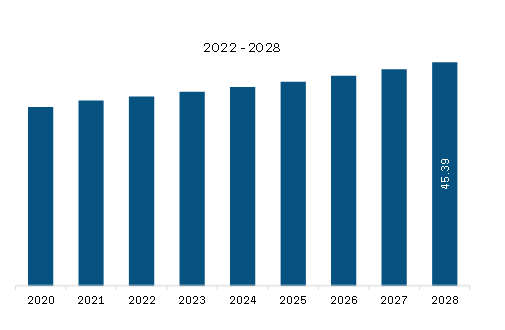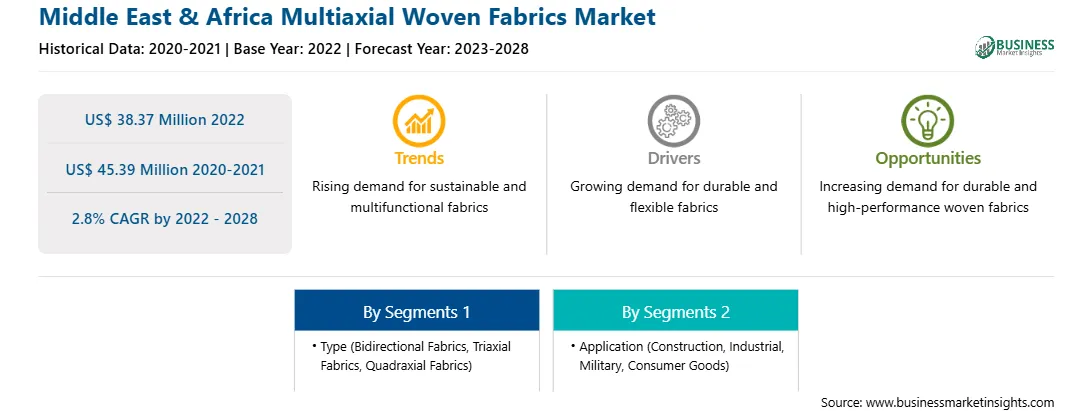Multiaxial fabrics are used for the reinforcement of composite materials. Rising demand for high-performance materials with properties such as high strength-to-weight ratio, good tensile strength, electrical conductivity, and others drives the growth of the composites industry. Also, there is a growing demand for composites from various end-use industries such as automotive, sporting goods, marine, construction, and wind energy. In the automotive industry, manufacturers prefer lightweight materials for manufacturing automobiles while ensuring safety and performance. Lightweight materials have excellent potential to increase fuel efficiency. Composites can reduce the weight of automotive components, which increases their use in the automotive sector. There is also a high demand for composites to be used as construction materials in high-performance sports gear due to their lightweight, high strength, freedom of design, and easy processing and forming characteristics. Composites are used in sports gear such as skis, baseball bats, golf clubs, tennis rackets, and bicycle frames. Composites are highly used in the marine industry as they are durable and lightweight. Composites weigh less than traditional marine construction materials, which makes them suitable for use in boat construction. Further, composites are used as reinforcing materials in several wind energy applications. High strength and stiffness, lightweight, design flexibility, and other characteristics of composites make them perfect materials for turbines. Also, composites are increasingly used in blade reinforcements, blade laminates, spar caps, blade root joints, and spacers. Rising use of composites in different end-use industries fuels the growth of the composites industry. Hence, the strong growth of the composites industry is bolstering the Middle East & Africa multiaxial woven fabrics market growth.
The Middle East & Africa has a massive demand for multiaxial woven fabrics in various countries such as the UAE, South Africa, and Saudi Arabia due to the growing requirement from the civil & marine engineering sectors. The demand for new residential projects has increased owing to a surge in migration from rural to urban areas. The increasing populace is also boosting the construction of residential areas. For instance, according to the United Nations report on Urbanization and Migration in Africa, the urban population of the region has been increasing at a high rate (i.e., from ~27% in 1950 to 40% in 2015) and is expected to reach 60% by 2050. Hence, due to the increasing demand for new construction in the region, the need for multiaxial woven fabrics has also grown. In addition, in automotive industry, multiaxial fabrics are used in manufacturing chassis and body parts. Carbon fiber is one of the most used fiber in manufacturing multiaxial fabrics for the automotive industry as they offer stiffness and low-density properties. This leads to a huge demand for multiaxial fabric in the automotive sector. Thus, the growth in demand for multiaxial fabric is attributed to the rising demand for lightweight vehicles to conserve fuel and enhance efficiency. As per the Organization of the Petroleum Exporting Countries (OPEC), the Middle East & Africa are expected to have 90 million vehicles on the road by 2040, up from 59 million in 2018.
Strategic insights for the Middle East & Africa Multiaxial Woven Fabrics provides data-driven analysis of the industry landscape, including current trends, key players, and regional nuances. These insights offer actionable recommendations, enabling readers to differentiate themselves from competitors by identifying untapped segments or developing unique value propositions. Leveraging data analytics, these insights help industry players anticipate the market shifts, whether investors, manufacturers, or other stakeholders. A future-oriented perspective is essential, helping stakeholders anticipate market shifts and position themselves for long-term success in this dynamic region. Ultimately, effective strategic insights empower readers to make informed decisions that drive profitability and achieve their business objectives within the market. The geographic scope of the Middle East & Africa Multiaxial Woven Fabrics refers to the specific areas in which a business operates and competes. Understanding local distinctions, such as diverse consumer preferences (e.g., demand for specific plug types or battery backup durations), varying economic conditions, and regulatory environments, is crucial for tailoring strategies to specific markets. Businesses can expand their reach by identifying underserved areas or adapting their offerings to meet local demands. A clear market focus allows for more effective resource allocation, targeted marketing campaigns, and better positioning against local competitors, ultimately driving growth in those targeted areas.
Middle East & Africa Multiaxial Woven Fabrics Strategic Insights

Middle East & Africa Multiaxial Woven Fabrics Report Scope
Report Attribute
Details
Market size in 2022
US$ 38.37 Million
Market Size by 2028
US$ 45.39 Million
Global CAGR (2022 - 2028)
2.8%
Historical Data
2020-2021
Forecast period
2023-2028
Segments Covered
By Type
By Application
Regions and Countries Covered
Middle East and Africa
Market leaders and key company profiles
Middle East & Africa Multiaxial Woven Fabrics Regional Insights

The Middle East & Africa multiaxial woven fabrics market is segmented into type, application, and country.
Based on type, the Middle East & Africa multiaxial woven fabrics market is segmented into bidirectional fabrics, triaxial fabrics, quadraxial fabrics, and others. In 2022, the quadraxial fabrics segment registered a largest share in the Middle East & Africa multiaxial woven fabrics market.
Based on application, the Middle East & Africa multiaxial woven fabrics market is segmented into construction, industrial, military, consumer goods, and others. In 2022, the industrial segment registered a largest share in the Middle East & Africa multiaxial woven fabrics market.
Based on country, the Middle East & Africa multiaxial woven fabrics market is segmented into South Africa, Saudi Arabia, the UAE, and the Rest of Middle East & Africa. In 2022, Saudi Arabia segment registered a largest share in the Middle East & Africa multiaxial woven fabrics market.
3D Weaving SaRL; Albany International Corp; Parabeam BV; SGL Carbon SE; and Sigmatex (UK) Ltd are the leading companies operating in the Middle East & Africa multiaxial woven fabrics market.
The Middle East & Africa Multiaxial Woven Fabrics Market is valued at US$ 38.37 Million in 2022, it is projected to reach US$ 45.39 Million by 2028.
As per our report Middle East & Africa Multiaxial Woven Fabrics Market, the market size is valued at US$ 38.37 Million in 2022, projecting it to reach US$ 45.39 Million by 2028. This translates to a CAGR of approximately 2.8% during the forecast period.
The Middle East & Africa Multiaxial Woven Fabrics Market report typically cover these key segments-
The historic period, base year, and forecast period can vary slightly depending on the specific market research report. However, for the Middle East & Africa Multiaxial Woven Fabrics Market report:
The Middle East & Africa Multiaxial Woven Fabrics Market is populated by several key players, each contributing to its growth and innovation. Some of the major players include:
The Middle East & Africa Multiaxial Woven Fabrics Market report is valuable for diverse stakeholders, including:
Essentially, anyone involved in or considering involvement in the Middle East & Africa Multiaxial Woven Fabrics Market value chain can benefit from the information contained in a comprehensive market report.